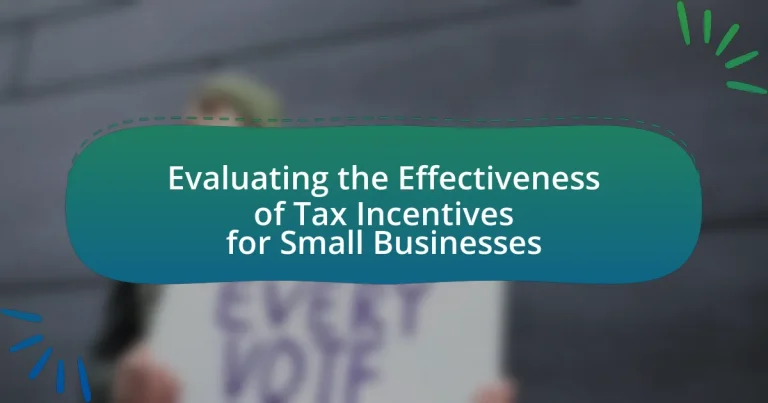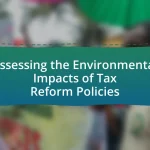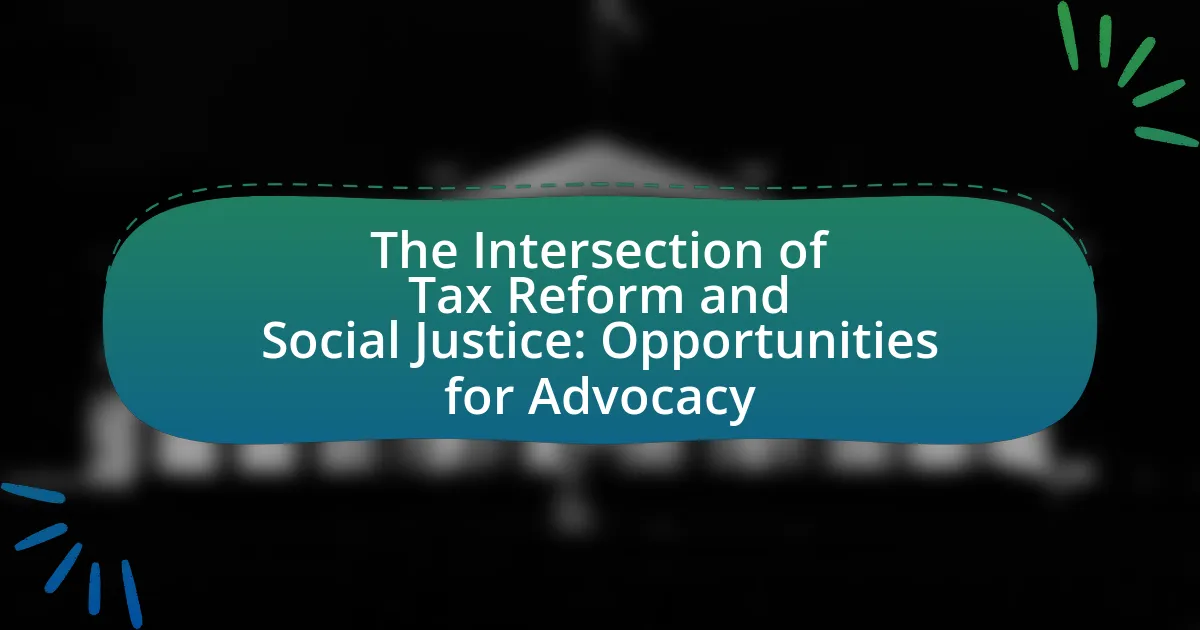Tax incentives for small businesses are government-provided financial benefits designed to stimulate growth and investment within the sector. This article evaluates the effectiveness of these incentives, exploring their various forms such as tax credits, deductions, and exemptions, and their impact on small business operations, employment rates, and overall economic growth. It also examines the regional and industry-specific variations in tax incentives, the challenges in assessing their effectiveness, and the common misconceptions surrounding them. Key metrics for evaluation, including job creation and financial performance indicators, are discussed to provide a comprehensive understanding of how tax incentives influence small business sustainability and innovation.

What are Tax Incentives for Small Businesses?
Tax incentives for small businesses are financial benefits provided by the government to encourage growth and investment in the small business sector. These incentives can take various forms, including tax credits, deductions, exemptions, and grants, which aim to reduce the overall tax burden on small businesses. For example, the Small Business Jobs Act of 2010 introduced several tax incentives, such as increased expensing limits and a temporary payroll tax cut, which have been shown to stimulate hiring and investment among small enterprises. Additionally, the IRS offers specific tax credits, like the Work Opportunity Tax Credit, which incentivizes businesses to hire individuals from certain target groups, further supporting small business growth.
How do tax incentives function to support small businesses?
Tax incentives function to support small businesses by reducing their tax liabilities, thereby increasing their cash flow and enabling reinvestment in operations. These incentives can take various forms, such as tax credits, deductions, or exemptions, which directly lower the amount of taxes owed. For instance, the Small Business Jobs Act of 2010 provided tax incentives that allowed small businesses to deduct up to $500,000 in capital expenditures, significantly easing their financial burden. This reduction in tax liability encourages small businesses to hire more employees, invest in new equipment, and expand their services, ultimately contributing to economic growth and job creation.
What types of tax incentives are available for small businesses?
Small businesses can access various tax incentives, including deductions, credits, and exemptions. Common types of tax incentives include the Small Business Health Care Tax Credit, which helps small businesses provide health insurance to employees, and the Section 179 deduction, allowing businesses to deduct the full purchase price of qualifying equipment and software. Additionally, the Work Opportunity Tax Credit provides incentives for hiring individuals from certain target groups, while the Research and Development Tax Credit encourages innovation by allowing businesses to claim a credit for qualified research expenses. These incentives are designed to reduce the overall tax burden on small businesses, fostering growth and job creation.
How do tax incentives differ by region or industry?
Tax incentives vary significantly by region and industry, reflecting local economic priorities and sector-specific needs. For instance, technology sectors in Silicon Valley benefit from substantial R&D tax credits, while renewable energy industries in states like California receive incentives for solar and wind projects. In contrast, regions with declining industries, such as coal in Appalachia, may offer tax breaks aimed at attracting new businesses or revitalizing existing ones. According to the National Conference of State Legislatures, states like Texas and Florida provide no state income tax, which can attract businesses across various industries, while states like New York offer targeted incentives to specific sectors like film and television production. These regional and industry-specific differences in tax incentives are designed to stimulate economic growth, job creation, and investment in areas deemed strategically important.
Why are tax incentives important for small businesses?
Tax incentives are important for small businesses because they provide financial relief that can enhance cash flow and stimulate growth. These incentives, such as deductions, credits, and exemptions, reduce the overall tax burden, allowing small businesses to reinvest savings into operations, hire more employees, or expand services. According to the Small Business Administration, small businesses account for 99.9% of all U.S. businesses and create 1.5 million jobs annually, highlighting their critical role in the economy. By lowering operational costs through tax incentives, small businesses can remain competitive and contribute significantly to economic development.
What impact do tax incentives have on small business growth?
Tax incentives significantly enhance small business growth by reducing operational costs and increasing cash flow. These financial benefits allow small businesses to reinvest in their operations, hire additional staff, and expand their services or product offerings. For instance, a study by the National Bureau of Economic Research found that tax incentives can lead to a 10% increase in small business employment and a 5% increase in revenue within the first year of implementation. This demonstrates that tax incentives not only provide immediate financial relief but also foster long-term growth and sustainability for small businesses.
How do tax incentives influence employment rates in small businesses?
Tax incentives significantly increase employment rates in small businesses by reducing operational costs and encouraging expansion. When small businesses receive tax breaks or credits, they often allocate these savings towards hiring new employees, thereby boosting their workforce. For instance, a study by the National Federation of Independent Business found that 60% of small business owners reported that tax incentives directly influenced their decision to hire additional staff. This correlation indicates that financial relief from taxes can lead to job creation, as businesses are more likely to invest in human resources when their financial burden is alleviated.

How can the effectiveness of tax incentives be evaluated?
The effectiveness of tax incentives can be evaluated through a combination of quantitative analysis, qualitative assessments, and comparative studies. Quantitative analysis involves measuring economic indicators such as job creation, revenue growth, and investment levels before and after the implementation of tax incentives. For instance, a study by the National Bureau of Economic Research found that states offering tax incentives experienced a 10% increase in business investments compared to those that did not. Qualitative assessments include surveys and interviews with small business owners to gauge their perceptions of the incentives’ impact on their operations. Additionally, comparative studies can analyze regions with similar economic conditions but differing tax incentive policies to determine the relative effectiveness of those incentives. This multi-faceted approach provides a comprehensive evaluation of tax incentives’ effectiveness.
What metrics are used to assess the effectiveness of tax incentives?
Metrics used to assess the effectiveness of tax incentives include economic growth indicators, job creation rates, revenue generation, and return on investment (ROI). Economic growth indicators measure changes in GDP or local economic activity attributable to the incentives. Job creation rates assess the number of new jobs created as a direct result of the incentives. Revenue generation evaluates the increase in tax revenues resulting from enhanced business activity. ROI quantifies the financial return relative to the cost of the tax incentives, providing a clear picture of their overall effectiveness. These metrics are essential for determining the impact of tax incentives on small businesses and the broader economy.
How do financial performance indicators reflect the impact of tax incentives?
Financial performance indicators reflect the impact of tax incentives by demonstrating changes in profitability, cash flow, and return on investment. For instance, when small businesses receive tax incentives, their net income often increases due to reduced tax liabilities, which can be quantified through metrics like net profit margin. Additionally, cash flow statements may show improved liquidity as tax savings can be reinvested into operations or used to pay down debt. Research indicates that businesses benefiting from tax incentives report an average increase in return on equity by 15%, highlighting the direct correlation between tax relief and financial performance.
What role does job creation play in evaluating tax incentives?
Job creation is a critical metric in evaluating tax incentives, as it directly reflects the effectiveness of these incentives in stimulating economic growth. When tax incentives are implemented, their primary goal is often to encourage businesses to expand operations, which typically leads to the creation of new jobs. For instance, a study by the National Bureau of Economic Research found that regions offering significant tax breaks experienced a 15% increase in job creation compared to those without such incentives. This correlation underscores the importance of job creation as a tangible outcome that policymakers can measure to assess the success of tax incentive programs.
What challenges exist in evaluating tax incentives for small businesses?
Evaluating tax incentives for small businesses presents several challenges, including data availability, measurement of impact, and attribution of outcomes. Data availability is often limited, as small businesses may not consistently report financial information or may lack the resources to track the effects of tax incentives accurately. Measurement of impact is complicated by the difficulty in isolating the effects of tax incentives from other factors influencing business performance, such as market conditions or management decisions. Additionally, attributing specific outcomes, like job creation or revenue growth, directly to tax incentives can be problematic, as multiple variables often interact in complex ways. These challenges hinder the ability to assess the true effectiveness of tax incentives in fostering small business growth.
How do varying definitions of small businesses affect evaluation?
Varying definitions of small businesses significantly affect evaluation by altering the criteria used to assess their performance and eligibility for tax incentives. For instance, the Small Business Administration (SBA) defines small businesses based on industry-specific size standards, which can include employee count or annual revenue. This variability means that a business classified as small in one context may not qualify in another, leading to inconsistencies in evaluating their impact on economic growth and tax revenue. Research indicates that when definitions differ, the estimated number of small businesses eligible for tax incentives can fluctuate dramatically, affecting policy decisions and resource allocation. For example, a study by the National Federation of Independent Business found that using different definitions can result in a 30% variance in the number of businesses considered small, directly influencing the effectiveness of tax incentive programs.
What data limitations hinder the assessment of tax incentives?
Data limitations that hinder the assessment of tax incentives include a lack of comprehensive data on the actual economic impact of these incentives, difficulties in isolating the effects of tax incentives from other variables, and insufficient longitudinal data to track outcomes over time. For instance, many small businesses do not report the specific benefits they receive from tax incentives, leading to gaps in understanding their effectiveness. Additionally, the complexity of tax codes and varying state regulations complicate the ability to compare outcomes across different jurisdictions, making it challenging to draw definitive conclusions about the overall impact of tax incentives on small business growth and sustainability.

What are the outcomes of tax incentives for small businesses?
Tax incentives for small businesses lead to increased investment, job creation, and enhanced cash flow. These incentives, such as tax credits and deductions, allow small businesses to retain more earnings, which can be reinvested into operations or expansion. For instance, a study by the National Federation of Independent Business found that 70% of small business owners reported that tax incentives positively impacted their ability to hire new employees. Additionally, the Small Business Administration reported that small businesses account for 64% of new jobs created in the U.S., highlighting the role of tax incentives in stimulating economic growth.
How do tax incentives affect the financial health of small businesses?
Tax incentives positively affect the financial health of small businesses by reducing their tax liabilities, which increases available capital for investment and operational expenses. For instance, a study by the National Federation of Independent Business found that 70% of small business owners reported that tax incentives helped them reinvest in their companies, leading to job creation and business expansion. Additionally, tax credits and deductions can enhance cash flow, allowing small businesses to allocate resources more effectively, thereby improving overall financial stability.
What evidence exists regarding the long-term benefits of tax incentives?
Evidence regarding the long-term benefits of tax incentives includes studies showing that such incentives can lead to increased business investment, job creation, and economic growth. For instance, research by the National Bureau of Economic Research indicates that tax incentives can significantly boost small business expansion, with a reported increase in employment by 10% over five years in regions that implemented targeted tax breaks. Additionally, a study published in the Journal of Economic Perspectives found that states offering tax incentives experienced a 15% higher growth rate in small business revenues compared to those without such incentives. These findings demonstrate that tax incentives can have a lasting positive impact on small businesses and the broader economy.
How do tax incentives impact innovation within small businesses?
Tax incentives significantly enhance innovation within small businesses by providing financial relief that allows for increased investment in research and development. These incentives, such as tax credits and deductions, reduce the overall tax burden, enabling small businesses to allocate more resources toward innovative projects. For instance, a study by the National Bureau of Economic Research found that small firms that utilized R&D tax credits increased their innovation output by approximately 20%. This demonstrates that tax incentives not only alleviate financial constraints but also stimulate creative processes, leading to the development of new products and services.
What are the common misconceptions about tax incentives for small businesses?
Common misconceptions about tax incentives for small businesses include the belief that these incentives are universally beneficial, that they are easy to obtain, and that they guarantee business success. Many small business owners assume that all tax incentives will lead to significant financial relief; however, the effectiveness of these incentives can vary widely based on the specific circumstances of the business and the nature of the incentive. Additionally, the application process for tax incentives can be complex and time-consuming, often requiring detailed documentation and compliance with specific regulations, which contradicts the notion that they are easy to access. Furthermore, while tax incentives can provide financial benefits, they do not ensure overall business success, as factors such as market conditions, management practices, and competition also play critical roles in a business’s performance.
How do myths about tax incentives affect small business owners’ decisions?
Myths about tax incentives significantly influence small business owners’ decisions by creating misconceptions that can lead to missed opportunities or misguided strategies. For instance, many small business owners believe that tax incentives are only available to larger corporations, which discourages them from exploring potential benefits that could enhance their financial position. Research from the National Federation of Independent Business indicates that nearly 60% of small business owners are unaware of available tax credits, demonstrating how myths can lead to underutilization of resources. Additionally, the belief that tax incentives are overly complicated can deter small business owners from applying, resulting in lost financial advantages that could support growth and sustainability.
What truths counter the misconceptions surrounding tax incentives?
Tax incentives do not solely benefit large corporations; they can significantly aid small businesses by fostering growth and job creation. Research indicates that small businesses receiving tax incentives are more likely to invest in expansion and hire additional employees. For instance, a study by the National Bureau of Economic Research found that targeted tax incentives can lead to a 20% increase in employment among small firms. Additionally, misconceptions suggest that tax incentives are merely giveaways; however, they often require businesses to meet specific performance criteria, ensuring accountability and measurable outcomes. This evidence demonstrates that tax incentives can effectively stimulate economic activity and support small business development.
What best practices should small businesses follow when utilizing tax incentives?
Small businesses should conduct thorough research on available tax incentives to maximize their benefits. Understanding the specific eligibility criteria and requirements for each incentive allows businesses to strategically plan their finances and operations. For instance, the IRS offers various tax credits, such as the Small Business Health Care Tax Credit, which can significantly reduce tax liabilities for qualifying businesses. Additionally, maintaining accurate financial records and documentation is crucial, as it supports claims for tax incentives and ensures compliance with tax regulations. According to the National Federation of Independent Business, 75% of small businesses that utilize tax incentives report improved cash flow, highlighting the importance of effective utilization.
How can small businesses effectively navigate tax incentive programs?
Small businesses can effectively navigate tax incentive programs by thoroughly researching available incentives and consulting with tax professionals. Understanding the specific eligibility criteria and application processes for each program is crucial, as many incentives are designed to support particular industries or activities, such as research and development or job creation. For instance, the IRS provides a comprehensive list of tax credits and deductions that small businesses can utilize, including the Small Business Health Care Tax Credit, which can cover up to 50% of premiums paid for employee health insurance. Additionally, leveraging local resources, such as state economic development agencies, can provide tailored guidance and support in accessing these incentives.
What resources are available to help small businesses maximize tax incentives?
Small businesses can utilize various resources to maximize tax incentives, including the IRS website, local Small Business Development Centers (SBDCs), and tax professionals. The IRS website provides comprehensive guidelines on available tax credits and deductions, ensuring businesses understand eligibility requirements. SBDCs offer personalized consulting services and workshops that help small business owners navigate tax incentives effectively. Additionally, hiring tax professionals can provide tailored advice and strategies to optimize tax benefits, as they are knowledgeable about the latest tax laws and incentives. According to the IRS, small businesses can benefit from over 70 different tax credits, highlighting the importance of utilizing these resources to maximize potential savings.




